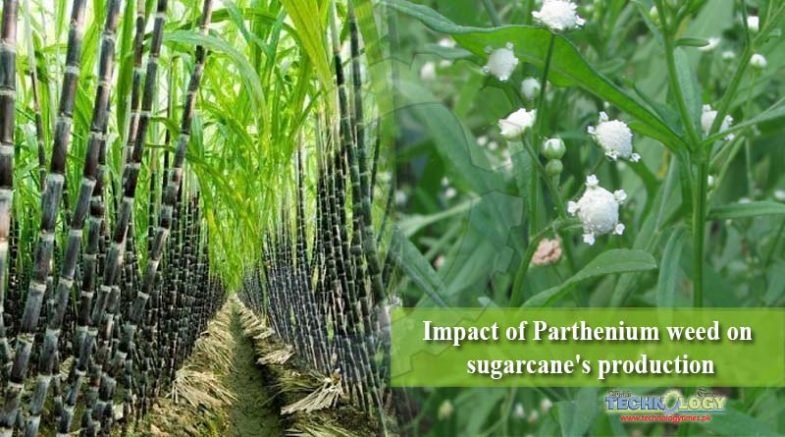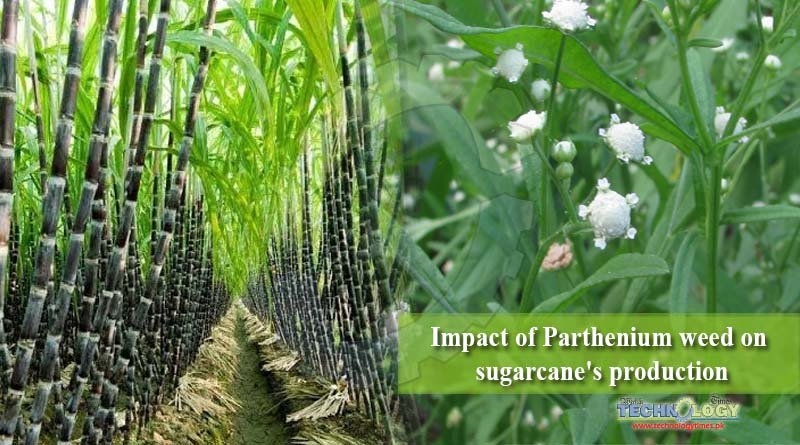Among these weeds, Parthenium is one of the most dangerous weeds which get incorporated into the soil and affected the early growth of the sugarcane.
 It is an annual perennial herb, that threatening the agro ecosystems and natural ecosystems in Pakistan and other 30 countries of the world. It is a native weed to the subtropics of North and South America but now has invaded Asia, Africa and Australia during the last 50 years.
It is an annual perennial herb, that threatening the agro ecosystems and natural ecosystems in Pakistan and other 30 countries of the world. It is a native weed to the subtropics of North and South America but now has invaded Asia, Africa and Australia during the last 50 years.
One of the major problems is associated with climate variability which ultimately leads to the emergence of new weeds in sugarcane fields. This weed reduces the production of sugarcane about 40% which is one of the adverse damage for cane growers with regards to low production
Parthenium hysterophorus L. is commonly known in both India and Australia and within a comparatively short period in both these countries, it has attained the status of major weed. In India, P. hysterophorus is uniquely called congress grass because the shape of the flower resembled the Congress building in New Delhi. This weed is also a serious weed of rangelands and pastures. This weed can decrease the carrying capacity of pastures via as much as 40% in Australia and up to 90% in India. In central Queensland, Australia, it is considered worst species, competing with both native and introduced pasture plants and resulting in losses of ca $A 100 million years.
By imported food grains, it accidentally introduced in India in 1995 and currently, it has occupied almost all the parts of India and in Pakistan, the weed has been speedily increased. It is the worst weed of family Asteracea with the potential to extend in many more regions and causing massive agricultural and ecological losses every year. Height of the completely grown plants 2.5 meters while most of them never exceed above 1.5 meters. The leaves are pubertal and deeply divided into narrow lobes. The shape of a small white flower (4 millimeters across) is like a star, grown on the tip of a stem.
The allelopathic nature of the plant, fast rate of growth and germination rapidly help the weed to suppress the neighboring vegetation. It permits to grow strongly and it produces a great number of seeds up to 20 000 seeds plant that increases the size of the seed bank of soil. The seeds of Parthenium weed are spread through farm machinery, animals feet, human and vehicles, can contaminate the pasture and carry in flood or river water.
Pakistan is included in these top ten countries that are mostly threatened by this weed. The weed is spreading rapidly, in rocky crevices, wastelands, along railway tracks, water channels and roadside, degraded areas in Pakistan. Recently, it has been reported in cultivated lands and achieved major weed status in Pakistan for the last 15-20 years. This weed is rapidly spreading in northern and southern Punjab. It is growing richly in wastelands, forests, grasslands, nearby the agricultural fields and sometimes in less competitive field crops, and is rapidly replacing the local vegetation.
Human and animal health
Parthenium weed is a toxic and allergenic plant, its health effects are being stated from almost all the countries where the weed spread. In effect humans directly or indirectly through airborne particles. Dermatitis, bronchitis, asthma, skin allergy and cancer are the main diseases due to Parthenium weed. The weed is also effecting the beef and milk production of cattle as well as cause death after 30 days if animals feed it an insignificant amount.
Control measures of Parthenium
Physical management
In several countries, the removal of parthenium weed by manually is not considered to be a cost-effective method due to the size of the weed invasions present and the cost of the labor in that country. Besides, this management method may also affect the health of the workers who are working to do this job, as parthenium weed is known to cause contact dermatitis and asthma. Moreover, populations of parthenium weed readily redevelop after manual removal and will regrow from a cut or partially pulled plants that still have a root system. Hand weeding and pulling approaches are commonly used in developing countries like India, Pakistan, Bangladesh, and Nepal where people are not conscious of the related health risks of contact with the plant that why labor is cheap in that country. Before reaching the plant’s flowering stage, ploughing-in the weed and then establishing pasture may be effective.
Chemical management:
Control of this herb by chemical method over the vast areas of rangelands, wastelands or within forests where the weed is commonly found is not cost-effective and timing of this method is significant. When plants of Parthenium are small and are at the pre-flowering stage then weed should be treated. Sustaining plant competition in meadows is vital for the effective management of parthenium weed, thus use the selective herbicides is recommended which do not haram or kill other species. For at least 7 years, it is then essential to monitor the treated area and spot spray any new plants that are found coming from the seed bank. In the chemical management of parthenium weed in several different situations, several selective herbicides like metsulfuron, glyphosate and paraquata have been reported to be effective.
Biological control
The most essential approaches used for the management of invasive weeds are classical biological control. In this method, plant pathogens or insect herbivores from the natural range of the weed are introduced, to destroy the growth of the weed, in the introduced range. Only four countries like Australia, India, South Africa, Sri Lanka, and Tanzania, so far have released biological control agents against parthenium weed. Additional two countries (Ethiopia and Vanuatu) are in the method of releasing biological control agents like Mexican beetle, Zygogramma bicolorata Pallister. Other countries like Kenya, Pakistan, Nepal, China, Ethiopia have agents that have accidentally attained there. In Australia, biological control is the most broadly used management tool for Parthenium weed where this approach has been examined for more than 20 years and was newly studied.
In Pakistan, Parthenium weed is spreading like cancer and it gradually destroys the fertility and especially it adversely effects on sugarcane crop. So there is dire need to create awareness campaigns through mass and print media in coordination with the public and private sector. Furthermore, to improve control measures of Parthenium through collaborative research so that averts an agricultural crisis in Pakistan.
